Summer '03 Road Trip |
|
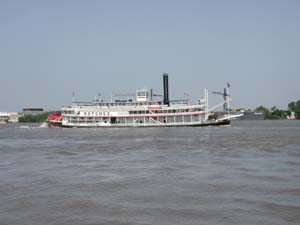
|
Summer, 2003, and we took a road trip from Arizona to New Orleans, cruising down that great transcontinental river called I-10. Ah, the lure of the Big Easy––the French Quarter ... Bourbon Street ... the Garden District ... above-ground cemeteries ... Mississippi paddlewheel boats ... Cajun and Creole food ... voodoo shops ... masked balls ... hurricane drinks ... street entertainers ... jazz and blues clubs ... flashers ... beads thrown from balconies ... streetcars – who wouldn’t be enticed to the great cresent bend of the Mississippi River? New Orleans, here we come ... and "BON TEMPS ROULLE". |

San AntonioOur first stop was San Antonio, home of the venerable Alamo and the newly venerated San Antonio Spurs. Every building in town had a “Go Spurs, Go” sign hanging on it, except, you might notice, for the still sacrosanct church where legendary American heroes lost their lives battling for Texan independence from Mexico (or as Cherie noted, another American war of aggression). The church, barracks, and the surrounding national historical park had displays on the history of the Alamo, the lives of the people on both sides of the conflict, and the living conditions at the time. All pretty interesting stuff, especially for a kid from the generation who grew up singing “Davy, Davy Crockett, king of the wild frontier.” It was cool to see where he fought and died and to look at his rifles and Jim Bowie’s knives. The Texan women and children survivors were holed up in the church at the end of the battle; the men were all lost as the Mexicans breached the walls surrounding the outpost. The history was palpable; the feeling was glum. But out of the tragedy came a renewed determination (remember the Alamo!) that soon led to victory over Santa Ana and Texan independence.
| |
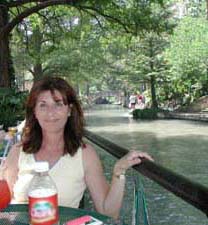
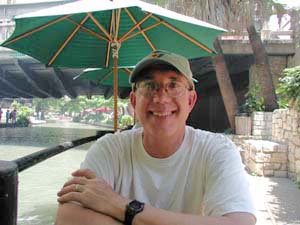 We spent most of our time in San Antonio along the Riverwalk. The river runs in a horseshoe shape through the heart of the city, and there are shops, restaurants, bars, hotels, cafes, and entertainment along the river. It is such a contrast–at street level the buildings tower over you, the traffic noise assaults you, and the heat wilts you; but walk down the steps to the river’s level and you’re suddenly in another world of trees, water, color, and charm. We had romantic strolls, a boat ride, and dinners and drinks along the river.
We spent most of our time in San Antonio along the Riverwalk. The river runs in a horseshoe shape through the heart of the city, and there are shops, restaurants, bars, hotels, cafes, and entertainment along the river. It is such a contrast–at street level the buildings tower over you, the traffic noise assaults you, and the heat wilts you; but walk down the steps to the river’s level and you’re suddenly in another world of trees, water, color, and charm. We had romantic strolls, a boat ride, and dinners and drinks along the river.
| |
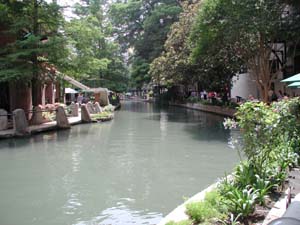
| |
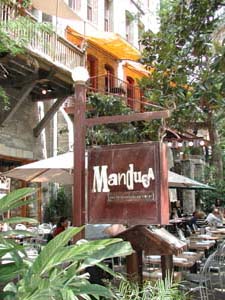
|
 People watching was great – lots of attractive women for me and lots of airmen in their blue uniforms for Cherie. Artists displayed their wares in a Little Village at a bend in the river; uptown we visited the Mexican market, where the restaurants were overflowing, the mariachi bands were blaring, the sidewalks were jammed with visitors, and the vendors were selling every trinket imaginable. You could swear you were in a Mexican border town.
People watching was great – lots of attractive women for me and lots of airmen in their blue uniforms for Cherie. Artists displayed their wares in a Little Village at a bend in the river; uptown we visited the Mexican market, where the restaurants were overflowing, the mariachi bands were blaring, the sidewalks were jammed with visitors, and the vendors were selling every trinket imaginable. You could swear you were in a Mexican border town.
|
Houston to Lafayette
|
|
| |
Cajon/Creole Country
Next stop was the heart of Louisiana’s Cajun country. I’ve read a lot of murder mystery books by James Lee Burke, who lives in and bases his stories in New Iberia Parish, and I wanted to see the area he paints so vividly in his books–the land of bayous, sugar cane farms, swamps, trees draped in Spanish moss, crushed shell parking lots, small towns with Main Streets and town squares. |
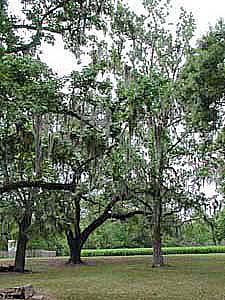 |
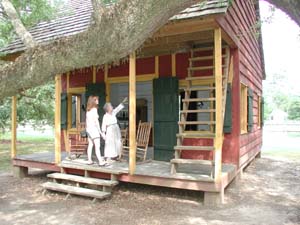 Cajun house along the Bayou Teche Cajun house along the Bayou Teche |
Cajun FarmLouisiana has a great state park at St. Martinville along the Bayou Teche that provided a glimpse into both Cajun and Creole life. It had a farm along the bayou with reconstructed Cajun houses and a guide who explained the history and lifestyle of the Cajun people–French-speaking Canadians who settled in southern Louisiana after being ejected from Canada by the British in the 1700s. | 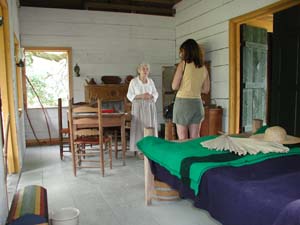 Inside the Cajun house Inside the Cajun house
|
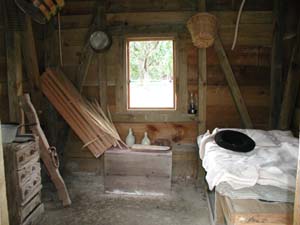 Inside an earlier Cajun house |
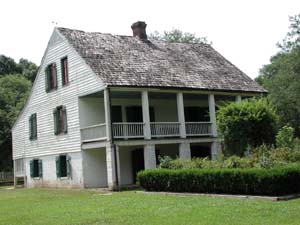 Creole plantation house Creole plantation house |
Creole PlantationAnd close by was a Creole plantation house, the Maison Olivier, where three generations of Creoles–French Europeans invited by their Cajun relatives to settle in the same area–raised their family, farmed the land, and managed a plantation employing some 30 slaves. Here too an interpretative guide gave us a rundown on the house and the families. Times were tough, only 7 of the 14 children of the last generation survived. | 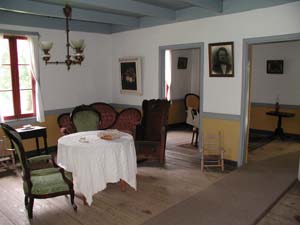 The parlor where the ladies retired The parlor where the ladies retired
|
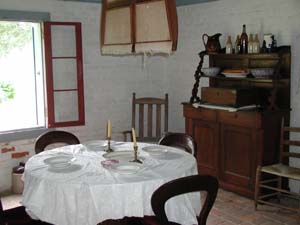 The dining room included a hand-pulled overhead fan |
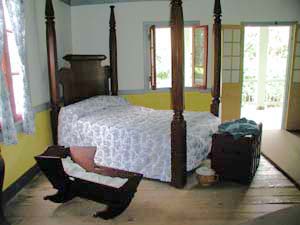 The master bedroom The master bedroom |
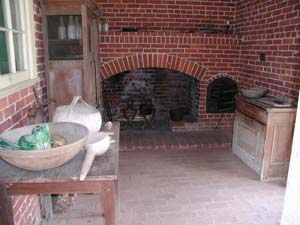 The kitchen is a separate outdoor building |
| This corner of Louisiana is off the beaten path, navigated by two lane roads which branch off without warning, dotted by villages interspersed with farmland and a few ugly business strips. The people are folksy, though. When we drove through New Iberia, one of the locals started following our car, and when we pulled over to do some walking, he pulled up and asked if we were from Arizona, (believe it was the license plate that gave us away), and if we knew Susanne, a girlfriend who apparently moved there a while back. (I was wondering if the young boy in the car might have been hers). He didn’t know where in Arizona she lived, but thought we might just know her. I was sorry to disappoint him. |
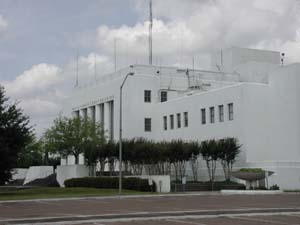 Speaking of disappointments, the town of New Iberia was not like I pictured it from Burke's novels. Though it was small, had a nice main street, and was intersected by the Bayou Teche, it looked as much like a small Michigan town as one in Louisiana. And we took the walking tour to see Dave Robicheau's sheriff's office, a quaint building near Main Street. Yep, here it is–about as quaint as Jackson State penitentary. Just goes to show, some things are purdier in the imagination than in the eyes.
Speaking of disappointments, the town of New Iberia was not like I pictured it from Burke's novels. Though it was small, had a nice main street, and was intersected by the Bayou Teche, it looked as much like a small Michigan town as one in Louisiana. And we took the walking tour to see Dave Robicheau's sheriff's office, a quaint building near Main Street. Yep, here it is–about as quaint as Jackson State penitentary. Just goes to show, some things are purdier in the imagination than in the eyes.
|
On to New Orleans! Click here to go to the New Orleans photos